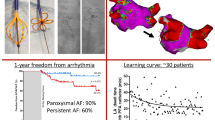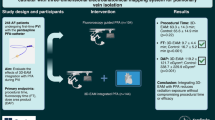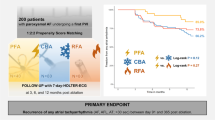Abstract
Background
Pulsed field ablation (PFA) is a novel method of cardiac ablation demonstrated in early pre-clinical and clinical settings. The aim of this study was to report the safety and clinical efficacy of pulmonary vein isolation (PVI) with PFA for real-world atrial fibrillation (AF) patients.
Methods
All-comer AF patients (n = 121, 59% paroxysmal) were prospectively included and underwent PFA with 100% high-density voltage maps performed after PVI. Clinical outcomes were gathered by chart review.
Results
PVI was achieved with PFA-only in 119 (98%) of the cases. During the implementation phase the mean procedure and fluoroscopy time was reduced from 85 ± 34 to 72 ± 18 min (p = 0.044) and 22 ± 9 to 16 ± 4 (p = 0.034). We observed one phrenic nerve palsy with only partial remission at follow-up. Other adverse events were numerically comparable to standard PVI procedures. Over a mean follow-up of 308 ± 87 days, a total of 22/121 (18.2%) cases experienced clinically significant recurrence or initiation of anti-arrhythmic drugs with Kaplan–Meier event-free estimate at 365 days of 80% (88% for paroxysmal versus 69% for persistent). In five of eight re-do procedures, gaps were primarily located at the right pulmonary veins.
Conclusions
PFA was a highly efficient method to achieve PVI with reductions in procedure time and fluoroscopy over the implementation period. The procedural data and clinical recurrence rates from initial trials were confirmed in real-life non-selected AF patients. More data is needed to establish lesion durability and limitations of PFA.









Similar content being viewed by others
References
Hindricks G, Potpara T, Dagres N, Arbelo E, Bax JJ, Blomstrom-Lundqvist C, et al. 2020 ESC Guidelines for the diagnosis and management of atrial fibrillation developed in collaboration with the European Association for Cardio-Thoracic Surgery (EACTS): the Task Force for the diagnosis and management of atrial fibrillation of the European Society of Cardiology (ESC) Developed with the special contribution of the European Heart Rhythm Association (EHRA) of the ESC. Eur Heart J. 2021;42(5):373–498.
Sorensen SK, Johannessen A, Worck R, Hansen ML, Hansen J. Radiofrequency Versus cryoballoon catheter ablation for paroxysmal atrial fibrillation: durability of pulmonary vein isolation and effect on atrial fibrillation burden: the RACE-AF randomized controlled trial. Circ Arrhythm Electrophysiol. 2021;14(5):e009573.
Neven K, van Es R, van Driel V, van Wessel H, Fidder H, Vink A, et al. Acute and long-term effects of full-power electroporation ablation directly on the porcine esophagus. Circ Arrhythm Electrophysiol. 2017;10(5).
Neven K, Futing A, Byrd I, Heil RW Jr, Fish JM, Feeney DA, et al. Absence of (sub-)acute cerebral events or lesions after electroporation ablation in the left-sided canine heart. Heart Rhythm. 2021;18(6):1004–11.
Koruth JS, Kuroki K, Kawamura I, Brose R, Viswanathan R, Buck ED, et al. Pulsed Field ablation versus radiofrequency ablation: esophageal injury in a novel porcine model. Circ Arrhythm Electrophysiol. 2020;13(3):e008303.
Reddy VY, Dukkipati SR, Neuzil P, Anic A, Petru J, Funasako M, et al. Pulsed field ablation of paroxysmal atrial fibrillation: 1-year outcomes of IMPULSE, PEFCAT, and PEFCAT II. JACC Clin Electrophysiol. 2021;7(5):614–27.
Reddy VY, Neuzil P, Koruth JS, Petru J, Funosako M, Cochet H, et al. Pulsed field ablation for pulmonary vein isolation in atrial fibrillation. J Am Coll Cardiol. 2019;74(3):315–26.
Reddy VY, Anic A, Koruth J, Petru J, Funasako M, Minami K, et al. Pulsed field ablation in patients with persistent atrial fibrillation. J Am Coll Cardiol. 2020;76(9):1068–80.
Ruwald MH, Johannessen A, Hansen ML, Haugdal M, Worck R, Hansen J. Utility of high-density 3d-bipolar voltage map after pulmonary vein isolation by pulsed-field ablation. JACC: Clin Electrophysiol. 2023. https://doi.org/10.1016/j.jacep.2022.11.030
Lyng Lindgren F, Brix Christensen S, Lundbye-Christensen S, Kragholm K, Johannessen A, Jacobsen PK, et al. Validation of the national Danish ablation database: a retrospective, registry-based validation study. Scand Cardiovasc J. 2022;56(1):285–91.
Ekanem E, Reddy VY, Schmidt B, Reichlin T, Neven K, Metzner A, et al. Multi-national survey on the methods, efficacy, and safety on the post-approval clinical use of pulsed field ablation (MANIFEST-PF). Europace. 2022;24(8):1256–66.
Duytschaever M, De Pooter J, Demolder A, El Haddad M, Phlips T, Strisciuglio T, et al. Long-term impact of catheter ablation on arrhythmia burden in low-risk patients with paroxysmal atrial fibrillation: The CLOSE to CURE study. Heart Rhythm. 2020;17(4):535–43.
Nakagawa H, Castellvi Q, Neal R, Girouard S, Ikeda A, Kuroda S, et al. Effects of contact force on lesion size during pulsed field ablation. Heart Rhythm. 2021;18(PO03-131):S242–3.
Futing A, Reinsch N, Howel D, Brokkaar L, Rahe G, Neven K. First experience with pulsed field ablation as routine treatment for paroxysmal atrial fibrillation. Europace. 2022.
Schmidt B, Bordignon S, Tohoku S, Chen S, Bologna F, Urbanek L, et al. 5S study: safe and simple single shot pulmonary vein isolation with pulsed field ablation using sedation. Circ Arrhythm Electrophysiol. 2022;15(6):e010817.
Andrade JG, Champagne J, Dubuc M, Deyell MW, Verma A, Macle L, et al. Cryoballoon or radiofrequency ablation for atrial fibrillation assessed by continuous monitoring: a randomized clinical trial. Circulation. 2019;140(22):1779–88.
Andrade JG, Deyell MW, Verma A, Macle L, Khairy P. The cryoballoon vs irrigated radiofrequency catheter ablation (CIRCA-DOSE) study results in context. Arrhythm Electrophysiol Rev. 2020;9(1):34–9.
Worck R, Sorensen SK, Johannessen A, Ruwald M, Haugdal M, Hansen J. Posterior wall isolation in persistent atrial fibrillation feasibility, safety, durability, and efficacy. J Cardiovasc Electrophysiol. 2022;33(8):1667–74.
Lemoine MD, Fink T, Mencke C, Schleberger R, My I, Obergassel J, et al. Pulsed-field ablation-based pulmonary vein isolation: acute safety, efficacy and short-term follow-up in a multi-center real world scenario. Clin Res Cardiol. 2022. https://doi.org/10.1007/s00392-022-02091-2
Bohnen M, Weber R, Minners J, Jadidi A, Eichenlaub M, Neumann FJ, et al. Characterization of circumferential antral pulmonary vein isolation areas resulting from pulsed-field catheter ablation. Europace. 2022. https://doi.org/10.1093/europace/euac111
Tohoku S, Chun KRJ, Bordignon S, Chen S, Schaack D, Urbanek L, et al. Findings from repeat ablation using high-density map** after pulmonary vein isolation with pulsed field ablation. Europace. 2022. https://doi.org/10.1093/europace/euac211
Ruwald MH, Johannessen A, Hansen ML, Worck R, Hansen J. Pulsed field ablation of the cavotricuspid isthmus using a multispline-electrode pulsed field ablation catheter. HeartRhythm Case Rep. 2022;8(3):147–50.
Reddy VY, Petru J, Funasako M, Kopriva K, Hala P, Chovanec M, et al. Coronary arterial spasm during pulsed field ablation to treat atrial fibrillation. Circulation. 2022;146(24):1808–19
Author information
Authors and Affiliations
Corresponding author
Ethics declarations
Conflict of interest
MHR, AJ, MLH and MH has nothing to disclose. RW has received research grants and speaker honoraria from Biosense Webster not related to the present work and JH has received grants, speaker honoraria and consultant fees from Biosense Webster and speaker honoraria and consultant fees from Boston Scientific.
Ethical approval
This research study was conducted retrospectively from data obtained for clinical purposes utilising anonymized data approved by Herlev-Gentofte University Hospital Institutional Review Board (Case Number:22035743).
Additional information
Publisher's Note
Springer Nature remains neutral with regard to jurisdictional claims in published maps and institutional affiliations.
What’s new:
*Single-shot pulsed field ablation with map** allowed for a relatively short learning curve with reduced short procedure and fluoroscopy times during implementation.
*Pulsed field ablation resulted in a high rate of acute pulmonary vein isolation, low rate of adverse events and a slightly lower rate of clinical recurrences than what has been reported for radiofrequency or cryoballoon ablation.
*Operator experience and use of high-density map** prompted a temporal change towards more frequent pulsed field ablation with left atrium posterior wall isolation, which was deemed feasible and with relatively low procedure times.
*We observed one phrenic nerve palsy unresolved at follow-up. This unexpected finding warrants further verification in larger cohorts.
*Re-do procedures suggest limited durability of right sided PV ablations.
Rights and permissions
Springer Nature or its licensor (e.g. a society or other partner) holds exclusive rights to this article under a publishing agreement with the author(s) or other rightsholder(s); author self-archiving of the accepted manuscript version of this article is solely governed by the terms of such publishing agreement and applicable law.
About this article
Cite this article
Ruwald, M.H., Johannessen, A., Hansen, M.L. et al. Pulsed field ablation in real-world atrial fibrillation patients: clinical recurrence, operator learning curve and re-do procedural findings. J Interv Card Electrophysiol 66, 1837–1848 (2023). https://doi.org/10.1007/s10840-023-01495-y
Received:
Accepted:
Published:
Issue Date:
DOI: https://doi.org/10.1007/s10840-023-01495-y




